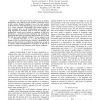Free Online Productivity Tools
i2Speak
i2Symbol
i2OCR
iTex2Img
iWeb2Print
iWeb2Shot
i2Type
iPdf2Split
iPdf2Merge
i2Bopomofo
i2Arabic
i2Style
i2Image
i2PDF
iLatex2Rtf
Sci2ools
GLOBECOM
2009
IEEE
2009
IEEE
Super-Gaussian Loading for Robust Beamforming
— It is well known that the performance of adaptive beamformers may degrade in the presence of steering errors. In this context, diagonal loading is one of the most popular methods used for robust beamforming, and can be derived from an 2 norm constraint. Equivalently, this method assumes a white Gaussian prior on the beamforming vector, similar to ridge regression in statistical point of view. By changing the loading level, which can be treated as confidence of this prior distribution, a trade-off between robustness and adaptivity is obtained. In this article, we generalize this approach via p norms. We find that under different settings, it is not optimal to set p = 2 compared with other p ∈ [1, 2] with the loading level chosen in such a way that the prior variance is maintained. We derive an iterative form to calculate the beamformer, as well as an iterative online implementation. Convergence is observed in empirical simulations and discussed under certain conditions.
| Added | 04 Sep 2010 |
| Updated | 04 Sep 2010 |
| Type | Conference |
| Year | 2009 |
| Where | GLOBECOM |
| Authors | Jing Gu, Patrick J. Wolfe |
Comments (0)

